


Desserto says its organic cactus plantations in Zacatecas, Mexico, use 164,650% less water compared with animal leather and 190% compared with polyurethane.Īn outfit by Stella McCartney made from Mylo. This customisation creates a range of design possibilities, minimises waste and ensures consistent quality.”īecause these companies have been formed with sustainability in their DNA, good agricultural practice is front and centre. We control each sheet’s size, strength, flexibility, thickness. “Our materials are essentially made to order and there’s complete transparency into what is being made and how. “It’s more than a new material – it’s a manufacturing breakthrough that gives designers new levels of customisation and creative control,” says MycoWorks co-founder Sophia Wang. This produces a strong cellular material that can be processed to give a luxury leather effect. Hermès worked with the Californian company MycoWorks to make Sylvania, which uses a technology called Fine Mycelium. Mycelium, the root structure of fungus, has become a favourite in the luxury industry. The truth is, the challenges are so great right now, that the demand for innovative solutions far outstrips the supply.”īio-textiles are made either from agricultural byproducts or specially grown crops. I, and our employees, have been massively impacted by climate change and fires. The people behind these new materials come from diverse backgrounds – fashion and art, science and business – and they bring fresh perspective to the world of textiles.ĭan Widmaier, chief executive of the bio-textile company Bolt Threads, says: “This is personal for me. This change in priorities is the motivation for many of the companies developing so-called bio-leathers.

Trainers made from Nike’s new Happy Pineapple range made from Pinatex pineapple leather Photograph: nike “It’s especially important to young people, but we’re all becoming more empathic, we understand that we have to respect nature and be kind to each other.” “There’s a huge drive for transparency,” says Carmen Hijosa, founder of Ananas Anam, a company that makes a leather-style textile from pineapple. Customer concern about supply chains and methods of production was growing before the pandemic, but has accelerated in the past 18 months. There’s also been an attitude shift among consumers. “As a rule of thumb, tanning one tonne of hide results in 20-80 cubic metres of polluted waste water, not to mention the offal effluence from preparation, and pesticides to stop mould growth during transportation.” “Even in fully modernised tanneries it’s nearly impossible to reclaim pollutants generated by the tanning process,” says Adrián López Velarde, co-founder of Desserto, a Mexican company that makes leather-look material from cactus. We need to look towards circular economy alternatives, including the use of agricultural residues to create bio-leathers.”Īlthough conventional leather makes use of animal byproducts, production also involves toxic chemicals. “We urgently need to fix our relationship with fashion to halt unsustainable agricultural practices.
#MAN CARRY HERMES VICTORIA III DRIVER#
“Cattle ranching is already the largest driver of deforestation in the Amazon,” says Carry Somers, co-founder of Fashion Revolution, the world’s largest fashion activism organisation. Fashion creates a high level of pollution – from overproduction of clothing and synthetic fibres, and also from animal leather production. The growth of bio-textile lookalikes for leather is driven by the fashion industry’s efforts to improve sustainability, though they’re also used in the car and furniture industries. The new materials are made using biotechnology. Many of the first generation of vegan alternatives used plastic – which also has devastating environmental consequences and can take hundreds of years to decompose. Mushrooms, pineapples, grapes, cactus and apples are just some of the organisms on the receiving end of billions of dollars of research and development funding to create leather and plastic replacements.


 0 kommentar(er)
0 kommentar(er)
